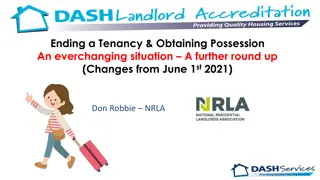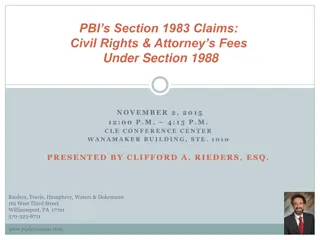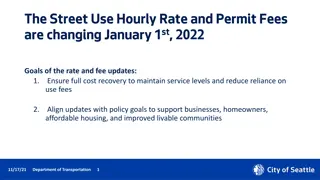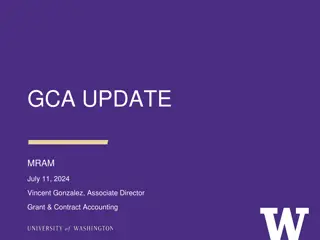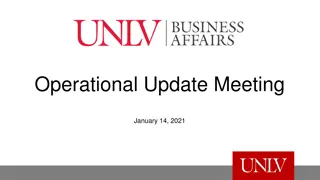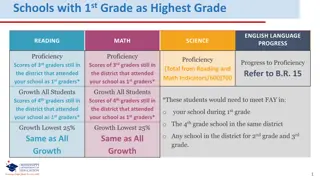
Section 3 Updates Effective July 1st, 2021
The purpose of Section 3 of the Housing and Urban Development Act of 1968 is to provide job, training, and contracting opportunities for low and very-low-income individuals and businesses. Discover the important definitions, requirements, and best practices associated with Section 3 to ensure proper implementation and compliance with HUD funding mandates.
Uploaded on | 1 Views
Download Presentation

Please find below an Image/Link to download the presentation.
The content on the website is provided AS IS for your information and personal use only. It may not be sold, licensed, or shared on other websites without obtaining consent from the author. If you encounter any issues during the download, it is possible that the publisher has removed the file from their server.
You are allowed to download the files provided on this website for personal or commercial use, subject to the condition that they are used lawfully. All files are the property of their respective owners.
The content on the website is provided AS IS for your information and personal use only. It may not be sold, licensed, or shared on other websites without obtaining consent from the author.
E N D
Presentation Transcript
Section 3 Updates Effective July 1st, 2021
Learning Objectives Learning Objectives Purpose of Section 3 Important Section 3 Definitions Applying Section 3 Section 3 Benchmarks Steps for Implementing Section 3 Requirements Properly Section 3 Best Practices
Purpose of Section 3 Purpose of Section 3
Section 3 Purpose Section 3 Purpose The purpose of Section 3 of the Housing and Urban Development Act of 1968 (Section 3) is to provide jobs, training, and contracting opportunities for low and very-low-income persons and the businesses that substantially employ them through HUD funding. Section 3 requires HUD funding recipients to identify, hire, and train low-income persons when working on new construction, demolition, or rehabilitation projects that exceed $200,000 in HUD funding.
Section 3 and LMI Section 3 and LMI Section 3 opportunities are targeted for low and very-low-income workers in connection with the projects in their neighborhoods. Low- income levels are defined as 80% or below the area median income (AMI) for an individual; very-low-income is defined as 50% or below AMI. Section 3 is not based on race or gender. Section 3 is based on income and location.
Important Definitions Important Definitions
Section 3 Worker Defined Section 3 Worker Defined A Section 3 worker is any worker who currently fits, or when hired within the past five years fit, at least one of the following categories, as documented: 1. The worker s income for the previous or annualized calendar year is below the income limit established by HUD; or 2. The worker is employed by a Section 3 business concern; or 3. The worker is a YouthBuild participant.
Targeted Section 3 Worker Defined Targeted Section 3 Worker Defined A Targeted Section 3 Worker is a Section 3 worker who is: 1. Employed by a Section 3 business concern; or within the last five years fits one of the following: 2. A Section 3 worker living in the project s service area or neighborhood; or 3. A YouthBuild participant.
Section 3 Business Concern Defined Section 3 Business Concern Defined A Section 3 business concern is one that is formed according to state law and properly licensed for its business activity. This may be a non-profit. A Section 3 business concern must meet one of the following criteria: 1. The business is 51% or more owned by low or very-low-income persons. 2. 75% or more labor hours are performed by Section 3 workers or YouthBuild participants. 3. 51% or more owned by current residents of public housing or Section 8 assisted housing.
Identify Section 3 Business Concerns Identify Section 3 Business Concerns Recipients may seek Section 3 business concerns through a Request for Qualifications for specific bids on proposed projects or consult HUD s Business Registry. The registry provides a collection of tools to assist recipients of HUD funding find contractors.
Important Consideration for Section 3 Important Consideration for Section 3 Section 3 does not require the employment of a Section 3 worker or the contracting with a Section 3 business who does not meet the qualifications of the position or contract.
Applying Section 3 Applying Section 3
When does Section 3 apply? When does Section 3 apply? Section 3 requirements apply to work arising in connection with the new construction, demolition, or rehabilitation of a project. All Public Housing HUD funded projects regardless of the dollar amount of HUD funding are subject to Section 3 requirements. Housing and Community Development Assistance funded projects that are fully or partially funded with HUD assistance are subject to Section 3 requirements if the project meets the threshold of $200,000 in total HUD assistance.
Who is Responsible for Section 3 Economic Who is Responsible for Section 3 Economic Opportunities? Opportunities? Recipients of HUD financial assistance (i.e., Developers, for profit developers, nonprofit developers, public housing authorities, and developers, nonprofit developers, public housing authorities, and ADFA designated community housing development organizations ADFA designated community housing development organizations (CHDOs (CHDOs), and their contractors and subcontractors, are required to make economic opportunities available to eligible Section 3 workers. Developers, for profit
Section 3 Benchmarks Section 3 Benchmarks
Benchmarks Benchmarks 1. Twenty-five (25) percent or more of the total number of labor hours worked by all workers on a Section 3 applicable project are Section 3 workers. (Section 3 Labor Hours/Total Labor Hours = 25%) and 2. Five (5) percent or more of the total number of labor hours worked by all workers on a Section 3 applicable project are Targeted Section 3 workers. (Targeted Section 3 Labor Hours/Total Labor Hours = 5%)
Benchmarks Example Benchmarks Example Project X has 50 employees of which 14 are identified as Section 3 workers. Project X completed all work with a total of 1000 labor hours. Section 3 workers portion of the total labor hours is 280 hours. 280 Section 3 Labor Hours/1000= 28% (Benchmark: Section 3 Labor Hours/Total Labor Hours = 25%) Of the 14 Section 3 workers, 4 are identified as Targeted Section 3 workers. These Targeted workers portion of the total labor hours is 80 hours. 80 Targeted Section 3 Labor Hours/1000= 8% (Benchmark: Targeted Section 3 Labor Hours/Total Labor Hours = 5%)
Implementing Section 3 Implementing Section 3 In Three Easy Steps
Step 1: Identify Section 3 Workers Step 1: Identify Section 3 Workers Contractor advertises and hires employees (if already hired, simply skip to certification) Once hired, identify Section 3 Workers and document status Two primary options for identifying and documenting Section 3 status: 1. Worker Self Certification 2. Employer Certification
Step 1(a): Advertise and Recruit Section 3 Step 1(a): Advertise and Recruit Section 3 Workers Workers Contractor advertises and hires employees (if already hired, simply skip to certification) Document your advertising and recruitment efforts
Step 1(b) Step 1(b)- - Documenting Section 3 Status Documenting Section 3 Status Worker Self-Certification Options (One of the Following) 1. Income from the prior calendar year is below 80% area median income according to the HUD 2. Currently participating in the YouthBuild program Employer Certification Options (One of the Following) 1. Employer confirms that the worker s income from that employer is below 80% area median income 2. Employer confirms that the worker is employed by a Section 3 business concern
Step 1(c): Identify Targeted Section 3 Workers Step 1(c): Identify Targeted Section 3 Workers Worker Self-Certification Options (One of the Following) 1. Currently participating in the YouthBuild program 2. Income from the prior calendar year is below 80% area median income and the employee lives within the project s service area (defined as within a one-mile radius of the project; if fewer than 5,000 people live within that radius, the circle may be expanded until that population is reached); residence must be confirmed by employer.
Step 1(c): Identify Targeted Section 3 Workers Step 1(c): Identify Targeted Section 3 Workers Employer Certification Options (One of the Following) 1. Employer confirms that the worker s income from that employer is below 80% area median income and lives within employment radius 2. Employer confirms that the worker is employed by a Section 3 business concern
Important Details to Step 1 Important Details to Step 1 All Targeted Section 3 workers are Section 3 workers, but not all Section 3 workers are Targeted Section 3 workers Seek to identify and recruit Section 3 qualified workers first Be intentional in advertising job opportunities and DOCUMENT these efforts (copies of job advertisements, job fair notices, job fair attendees)
Step 2 Step 2- - Track and Monitor Labor Hours Track and Monitor Labor Hours Labor Hours Reporting Requirements HUD sought to tie Section 3 reporting requirements with standard business practices in that most developers, contractors, and subcontractors already track labor hours in a payroll system. For those employers who do not track labor hours in detail through a time-and-attendance system, HUD does not require employers to acquire such a system. Instead, they may provide a good faith assessment of the labor hours for an employee.
Step 3 Step 3- - Reporting Section 3 Efforts Reporting Section 3 Efforts- - Form 59 Form 59 Developers report Section 3 at completion. See HUD Forms 4736, 4736A, and 4736B Also HUD Forms 4737 (A,B,C,D) Documentation of Section 3 Identification (Step 1) and Documentation of Labor Hours (Step 2) will be requested. If Section 3 benchmarks are not met, the developers report on the qualitative efforts undertaken to meet those benchmarks.
What are Qualitative Efforts? What are Qualitative Efforts? If a contractor cannot meet benchmarks, the contractor should report on the efforts made by the contractor to recruit Section 3 workers. Examples of appropriate efforts: 1. Outreach efforts to generate job applicants who are Targeted Section 3 workers 2. Training/apprenticeship opportunities 3. Holding Job Fairs 4. Provide assistance to apply for/or attend education/vocational training 5. Provide financial literacy training 6. Engage in outreach to identify and secure bids from Section 3 business concerns 7. Promote use of Section 3 business registry and HUD Opportunity Portal
Documentation of Qualitative Efforts Documentation of Qualitative Efforts Documentation of efforts to comply with Section 3 should be maintained. Examples include: 1. Copies of direct mail solicitations 2. Email and internet outreach efforts 3. Formal advertisements 4. Flyers or brochures about meetings 5. Sign-in lists from job fairs and other public meetings 6. Agendas and/or meeting notes from meetings with contractors
Section 3 Best Practices Section 3 Best Practices Hold mandatory pre-bid meetings Hold Section 3 Workshops for contractors Include Section 3 Clause in all Covered Contracts Assess hiring needs at the beginning of contract award Remind contractors of the need to meet numerical goals for employment and contracting Review payroll data to verify a contractor s need for new hires. Re- hires are considered new hires
Section 3 Best Practices Section 3 Best Practices Match potential Section 3 workers or businesses with contractors Ensure contractors advertise vacancies YouthBuild Outreach Wesley "Wes" Cooper YOUTHBUILD Case Manager Arkansas Workforce Center at Little Rock Wesley.cooper@arkansas.gov Wes.cooper@equusworks.com Office: 501-320-5633 Cell: 501-313-8615 Make sure the debarred and suspended lists of contractors are checked Monitor contractors and establish penalties for non-compliance Document all qualitative efforts to recruit Section 3 workers
Questions and Resources Questions and Resources Contact Jason Bays Email: jason.bays@arkansas.gov Phone: (501) 682-5861 HUD Exchange Section 3 Resources HUD Opportunity Portal

